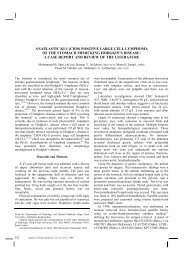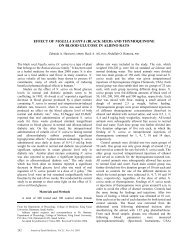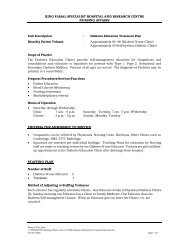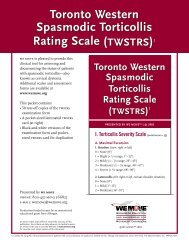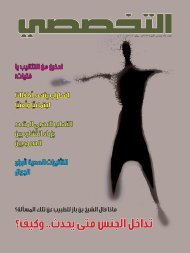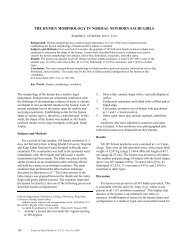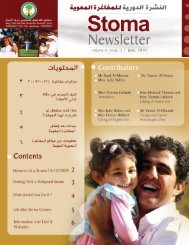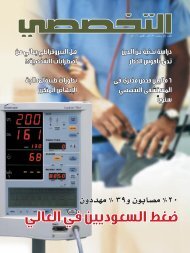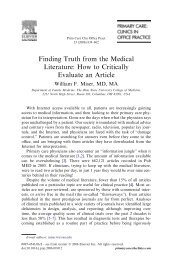A morpho-etiological description of congenital limb anomalies
A morpho-etiological description of congenital limb anomalies
A morpho-etiological description of congenital limb anomalies
Create successful ePaper yourself
Turn your PDF publications into a flip-book with our unique Google optimized e-Paper software.
CONGENITAL LIMB ANOMALIEScases with Poland sequence and classified the hand<strong>anomalies</strong> into seven types according to severity <strong>of</strong>the deformity. Sirenomelia (vitelline artery steal) isanother example <strong>of</strong> vascular disruption leading toabnormal caudal development. 24 Five cases (7.1%) inthe present study suffered from <strong>limb</strong> <strong>anomalies</strong> dueto vascular disruption in the embryonic blood vessels.Vascular anastomoses and discordant placental bloodflow in twins with a common placenta predisposethem to vascular disruptions. In approximately 1%<strong>of</strong> monozygotic twins, intrauterine death <strong>of</strong> one twinmay result in release <strong>of</strong> thromboplastin or emboli tothe surviving co-twin leading to ischemia in localizedareas. 17 One patient in the present study hadgangrene and muscle atrophy <strong>of</strong> both lower <strong>limb</strong>s.He was one <strong>of</strong> a triplet. Other causes <strong>of</strong> vasculardisruption include placental infarction, maternal hypotension,vasoactive drugs, agents like cocaine andcertain medications. 17 e prenatal diagnostic technique,chorionic villus sampling (CVS), has also beenassociated with <strong>limb</strong> reduction defect, with anoxia <strong>of</strong>distal fetal structures as a postulated etiology. 39Infants <strong>of</strong> diabetic mothers have 6% risk <strong>of</strong> developing<strong>congenital</strong> malformations. e risk maybe over 20% if there is poor control during thefirst trimester. e malformations involve the heart(transposition <strong>of</strong> great vessels), anencephaly, spinabifida, holoprosencephaly, cleft lip and/or palate, renal<strong>anomalies</strong> and caudal regression sequence. 17 Onecase with caudal regression in the present study wasan infant <strong>of</strong> an uncontrolled diabetic mother.Twenty cases (28.6%) in the present study had<strong>limb</strong> <strong>anomalies</strong> as one <strong>of</strong> the manifestations <strong>of</strong> sporadicsyndromes (syndromes with unknown etiology).Acheiria (rudimentary hand and fingers) andaphalangia (transverse <strong>limb</strong> <strong>anomalies</strong>) are probablycaused by death <strong>of</strong> the mesenchymal cells in the <strong>limb</strong>bud region. 40 Ruiter et al 41 have described absent lefthand (a terminal transverse reduction defect) in aboy with mosaic trisomy 22. ey observed that thistype <strong>of</strong> <strong>limb</strong> <strong>anomalies</strong> has never been reported inassociation with this chromosomal aberration. isfinding points out the importance <strong>of</strong> genetics in thework-up in sporadic cases <strong>of</strong> <strong>limb</strong> <strong>anomalies</strong>.Watson 42 stressed that management <strong>of</strong> <strong>congenital</strong><strong>limb</strong> <strong>anomalies</strong> has to include classificationand etiology, incidence, diagnosis before birth,and counseling <strong>of</strong> parents. In a similar study doneby Holder-Espinasse et al 43 on 107 cases <strong>of</strong> <strong>limb</strong><strong>anomalies</strong>, the diagnosis was made in 78%, includingisolated, syndromic, or chromosomal <strong>anomalies</strong>with the conclusion that prenatal multidisciplinaryFigure 3 (a,b). Limb <strong>anomalies</strong> due to fetal causes (single genedisorders).A newborn boy with bilateral postaxial synpolydactyly <strong>of</strong> the ringfinger (short arrows) and bilateral preaxial synpolydactyly <strong>of</strong> thebig toe (long arrow).Figure 4 (a,b). Limb <strong>anomalies</strong> due to environmental causes.Limb <strong>anomalies</strong> due to amniotic band disruption: a) constrictionrings (arrow), syndactyly, and ectrodactyly or terminal phalangesamputations; b) Transverse <strong>limb</strong> defect, i.e. amputation <strong>of</strong> both feet.Ann Saudi Med 25(3) May-June 2005 www.kfshrc.edu.sa/annals 225



